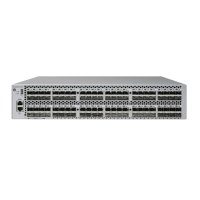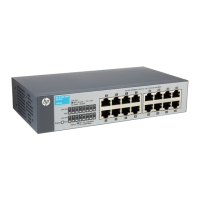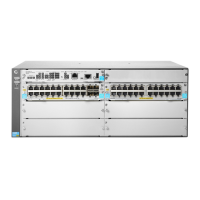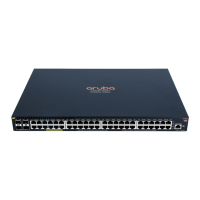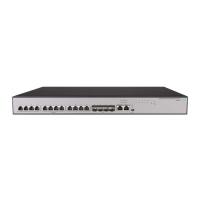209
Tasks at a glance Remarks
• Configuring one-to-two VLAN mapping
Configure one-to-two VLAN mapping on PE 1 and
PE 4, as shown in Figure 46, through
which traffic
from customer networks enter the service provider
networks.
Configuring two-to-two VLAN mapping
Configure two-to-two VLAN mapping on PE 3, as
shown in Figure 46,
which is an edge device of the
SP 2 network.
Configuring one-to-one VLAN mapping
Configure one-to-one VLAN mapping on the customer-side ports of wiring-closet switches
(see Figure 59) to isolate traf
fic of the same service type from different homes.
Before you configure one-to-one VLAN mapping, create the original VLAN and the translated VLAN.
To configure one-to-one VLAN mapping:
Step Command Remarks
1. Enter system view.
system-view
N/A
2. Enter Layer 2 Ethernet
interface view or Layer 2
aggregate interface view.
• Enter Layer 2 Ethernet interface
view:
interface interface-type
interface-number
• Enter Layer 2 aggregate
interface view:
interface bridge-aggregation
interface-number
N/A
3. Set the link type of the port.
• Configure the port as a trunk
port:
port link-type trunk
• Configure the port as a hybrid
port:
port link-type hybrid
By default, the link type of a
port is
access
.
4. Assign the port to the original
VLANs and the translated
VLANs.
• port trunk permit vlan
vlan-id-list
• port hybrid vlan vlan-id-list
tagged
N/A
5. Configure a one-to-one VLAN
mapping.
vlan mapping
vlan-id
translated-vlan
vlan-id
By default, no VLAN mapping
is configured on an interface.
Configuring many-to-one VLAN mapping
Configure many-to-one VLAN mapping on campus switches (see Figure 59) to transmit the same
type of traffic from different users in one VLAN.

